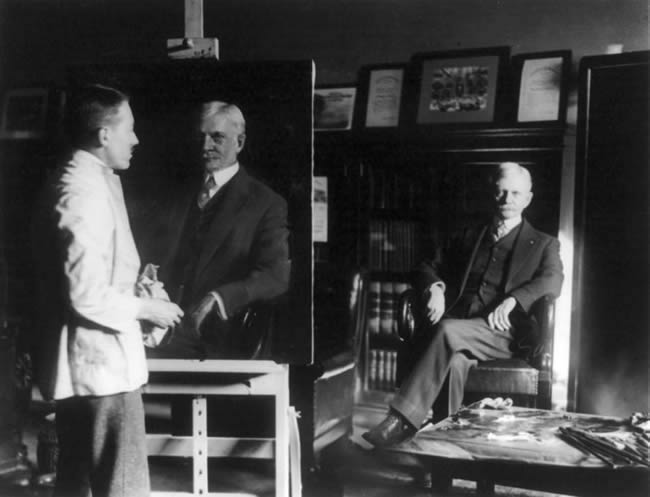
At some point in their careers, most artists have painted at least one or two portraits, whether it is a portrait of a family member or friend, or even a self-portrait. The goal in portrait-painting is not to get a photographic likeness, necessarily (unless you’re a photorealistic painter), but rather to capture the likeness and character of your subject.
There are many ways for contemporary artists to approach a portrait. They can be profile, frontal, or three-quarter view portraits. Portraits can be of the head only, or head and shoulders, or include the hands or the whole body. The subject can be seated, standing, or reclining, as in Mrs. Edouard Manet on a blue sofa, by Edouard Manet (1874), or even mounted on a horse, such as in the portrait of George Washington by Rembrandt Peale (1830). Portraits can be formal and posed, or candid and relaxed, the subject caught in a natural position; or they can be environmental portraits, showing the subject in an environment that is representative of their personality.
Drawing is important in capturing a likeness, but detail is not. Rather, it is the overall shape of the head and the relationship of the features to each other that is important. Although the average human head can be divided into relatively standard proportions, from person to person there is variation. The best way to see this is to have two people stand side by side and compare their faces and heads to each other. You will undoubtedly notice that one head is rounder, one longer, one pair of eyes is wider apart, one pair set closer, etc. This is a good exercise to practice in a classroom setting where there are several different people to compare to one another. The practice of observing and noticing the small differences in facial proportions is a good step in developing your drawing skills.
So, too, is carrying your sketchbook and doing quick studies of people as you have time, whether waiting at an airport, or at a doctor’s office, or in a cafe or restaurant. People will not be posing for you, so you have to work quickly.
The most efficient way to draw someone’s portrait quickly is to capture the values, that is the lights and darks. The light and dark values define the planes of the head created by the forehead and temples, the bridge and sides of the nose, the eye sockets, the cheekbones, the upper lip, and the chin. Depending on the direction of the light source, some of these areas will be highlighted and some will be shaded. Laying in these values accurately will quickly bring your portrait to life. Remember to squint in order to better see these values and to eliminate detail.
You can use the same approach with your painting that you use with your drawing. Whether painting from life or from a photograph, using a thin wash of burnt sienna, draw your subject on your canvas with your brush. An angled or flat brush is good to use because you can get both thin lines as well as broad strokes. Simplify the curves by using only straight lines to roughly draw in your subject. You can soften the angles later. If you're uncomfortable drawing with paint you can start with a soft pencil or charcoal and then use paint.
Fill your support completely with your subject. Don’t leave a little floating head in the middle of the canvas. That is one of the mistakes of the beginner painter. Rather, if you are working on a portrait that includes the head and shoulders, give your subject a presence on the canvas by making it large, with the eyes a little above halfway above the middle, and the shoulders falling off the canvas.
Once you have the general outline and rough placement for the features marked out with a few lines, start laying in the values with burnt sienna, using thicker paint for the darker areas and a thinner wash for the lighter areas. It is easy to correct errors at this stage. Paint in the background with a medium or dark value for contrast to make your portrait come forward from the background.
Finally, refine your values by mixing white with the burnt sienna as you work. For a darker value, you can add burnt umber. You can stop here with a monochromatic grisaille painting, or you can use this as an underpainting for doing a portrait painting in any style you want, whether that is realistic, fauvist, or impressionistic.
